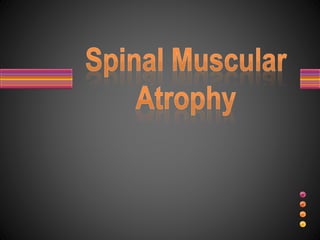Spinal Muscular Atrophy.pptx
•Download as PPTX, PDF•
0 likes•1 view
Spinal Muscular Atrophy
Report
Share
Report
Share

Recommended
Recommended
More Related Content
Featured
Featured (20)
Product Design Trends in 2024 | Teenage Engineerings

Product Design Trends in 2024 | Teenage Engineerings
How Race, Age and Gender Shape Attitudes Towards Mental Health

How Race, Age and Gender Shape Attitudes Towards Mental Health
AI Trends in Creative Operations 2024 by Artwork Flow.pdf

AI Trends in Creative Operations 2024 by Artwork Flow.pdf
Content Methodology: A Best Practices Report (Webinar)

Content Methodology: A Best Practices Report (Webinar)
How to Prepare For a Successful Job Search for 2024

How to Prepare For a Successful Job Search for 2024
Social Media Marketing Trends 2024 // The Global Indie Insights

Social Media Marketing Trends 2024 // The Global Indie Insights
Trends In Paid Search: Navigating The Digital Landscape In 2024

Trends In Paid Search: Navigating The Digital Landscape In 2024
5 Public speaking tips from TED - Visualized summary

5 Public speaking tips from TED - Visualized summary
Google's Just Not That Into You: Understanding Core Updates & Search Intent

Google's Just Not That Into You: Understanding Core Updates & Search Intent
The six step guide to practical project management

The six step guide to practical project management
Beginners Guide to TikTok for Search - Rachel Pearson - We are Tilt __ Bright...

Beginners Guide to TikTok for Search - Rachel Pearson - We are Tilt __ Bright...
Spinal Muscular Atrophy.pptx
- 2. Spinal Muscular Atrophy • Autosomal recessive disease affecting the (lower) motor neurons in the spinal cord and brainstem, resulting in progressive motor weakness and atrophy • Broad phenotype spectrum ranging in age of onset (birth to adulthood), severity, and clinical course – Types of SMA are primarily distinguished by the severity of muscle weakness and age of symptom onset – Types 1 & 2 are most severe
- 3. Type 0. This is the rarest and most severe form of SMA and develops while you’re still pregnant. Babies with this type of SMA move less in the womb and are born with joint problems, weak muscle tone, and weak muscles for breathing. They often do not survive due to breathing problems. Type 1. This is also a severe type of SMA. A child may not be able to support their head or sit without help. They may have floppy arms and legs and problems swallowing. The biggest concern is weakness in the muscles that control breathing. Most children with type 1 SMA don't live past age 2 because of breathing problems.
- 4. Type 2. This affects children 6-18 months old. The symptoms range from moderate to severe and usually involve the legs more than the arms. The child may be able to sit and walk or stand with help. Type 2 is also called chronic infantile SMA. Type 3. Symptoms for this type start when children are 2-17 years old. It's the mildest form of the disease. The child will most likely be able to stand or walk without help but may have problems running, climbing stairs, or getting up from a chair. Later in life, they may need a wheelchair to get around. Type 3 is also called Kugelberg-Welander disease or juvenile SMA. Type 4. This form of SMA starts when you're an adult. You may have symptoms such as muscle weakness, twitching, or breathing problems. Usually, only your upper arms and legs are affected. You'll have the symptoms throughout your life, but you can keep moving and even get better with exercises that you'll practice with the help of a physical therapist. It's important to remember that there's a lot of variation in the way this type of SMA affects people. Many people, for instance, are able to keep working for many years..
- 5. SMA is a disease that's passed down through families. If the child has SMA, it's because they have two copies of a broken gene, one from each parent. When this happens, their body won't be able to make a specific kind of protein. Without it, the cells that control muscles die. If the child gets a faulty gene from just one of the parents, they won't get SMA but will be a carrier of the disease,they could pass the broken gene to their own progeny. Spinal Muscular Atrophy Causes
- 6. Spinal Muscular Atrophy Diagnosis Muscle tissue biopsy MRI Blood test Nerve tests, such as an electromyogram (EMG) CT SCANS
- 7. PRESENTED BY – PRANAV KOHLI GROUP 10